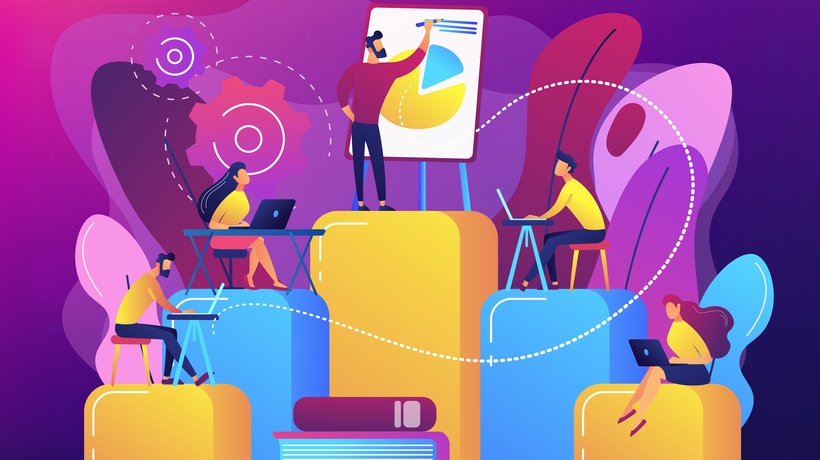
Adjust Training Programs To The “New Normal”
Before the COVID-19 pandemic, working from home seemed to be a challenge for any company because people found it hard to communicate and have discussions. However, working from home has now become the new trend in almost every company and organization. There have been new initiatives created to adjust working and training plans since people are forced to stay home. Instead of organizing face-to-face meetings, company leaders now have the tendency to apply technology and hold online meetings and online training sessions. According to App Annie’s latest report, in 2020, Microsoft Teams had more than 115 million daily active users. At the same time, Zoom and Google Meets were the top downloaded applications of the year.
Despite the necessity of modifying training programs in order to adapt to the new conditions, it is challenging for many L&D managers to come up with a suitable training plan. This article helps you to figure out the challenges that the new trends of working imposed by COVID-19 have created and what L&D managers can do to adjust their training strategy.
New Trends In Work Require Self-Study And Personal Development
With the rise of COVID-19, working from home has changed from a dream to a reality. People are used to the old working habits, directly discussing work with each other. Therefore, when switching to online working, they have difficulties adapting to the new routine. According to Buffer’s 2021 State of Remote Work report [1]:
- 41% of new remote workers said the biggest change is how they collaborate and communicate with colleagues.
- 22% said the biggest challenge is their location.
- 20% said their work hours are what has changed the most.
These challenges require employees to be equipped with certain skills, needed to ensure working progress and results. These are self-study and personal development.
Working in remote conditions requires self-discipline and willpower. Employees need to finish tasks without direct instruction from leaders. There is support from managers and colleagues, but most of the effort is from the employee. Their willpower encourages them to seek help from resources other than their managers to finish their work. With the chance to explore things themselves, employees are able to be active in working, meaning that they learn how to manage and complete work on their own. This will be the base for their personal development.
Some people are highly engaged in work and always search for opportunities for self-development. However, some are stuck with a lack of drive to learn. If you access some platforms where people ask and share discussions like Quora and The Workplace, you can see a topic about employees’ tendency to rely on managers and colleagues instead of doing research by themselves first. A software developer found it annoying to be constantly asked questions by a less-experienced colleague [2]. And of course, this led to discomfort and they had to look for advice. This example reflects the current reality about the ability of employees to engage in self-study, leading to a remarkable challenge for L&D managers. Training should be modified to provide employees with self-development opportunities. Now that we know it is essential to adjust the training plans, let’s move to the most “easier said than done” part: what do L&D managers find hard when modifying training plans?
Challenges For L&D Managers Revising Training Programs
1. Keeping Learners Engaged
The lack of traditional training classes, along with remote conditions, forces employees to complete training courses at home. However, employees can easily get distracted from the training content due to life interruptions, incoming calls/emails, or the temptation to surf the internet. Ben Waber, the president and cofounder of organizational analytics firm Humanyze shared, “If I’m trying to schedule a call, in the past it could have been that between 9 am and 5 pm, most of us would be available. Today, that’s not the case. It could be that I’m working from 7 am to 7 pm and available some of those hours.” Working time now is occupied by online shopping, using SNS, playing games, or even sleeping.
The negative information about the pandemic is one of the causes of the distraction of employees [3]. They feel discouraged and have less energy after hearing about the current COVID-19 situation. This problem raises a big question for L&D managers. How to create a training program that holds employees’ attention and sparks their curiosity to learn? Which platforms should they use to transfer the learning content?
2. Employees Want Remote Work
Many people now find they like remote work. According to a survey carried out by PWC, about 22% of employees shared that they are considering moving more than 50 miles away from the work office, while 46% of Gen Z and 47% of millennial employees prefer to work virtually [4]. During this long time working from home, employees have changed their working habits. They may be discouraged if they are called back to the office and in some situations, employees may even quit their jobs. A study by Robert Half shows that about 34% of professionals currently working from home would look for a new job if required to be in the office full time [5]. The concern is that permanent remote work may have a negative impact on the working progress of the business. This issue raises a challenge for company leaders to develop a strategy to engage and retain employees.
Solutions: How To Move On?
With the abovementioned challenges, it is obviously necessary that L&D managers come up with adjustments to the training programs. So, what are the solutions to cope with these problems?
1. Refine Training Purposes
Remote working conditions, along with changes in the workflow, led to uncertainty and loss of engagement among employees. Many of them are considering whether they should continue working or not. In these times, connection and trust between the company and employees are strongly required. If employees do not believe in the value that the company offers them, there is no reason for them to stay and contribute. As a result, the company will need to pay a huge amount for hiring and training employees to replace the ones who leave.
Therefore, it is necessary for leaders to revise and refine training purposes. New training purposes should focus on what employees need. When their demands are met, a close connection is created between the company and the employees. This enhances the engagement of employees, which contributes to the development of the business. Thus, carefully refining why these training courses need to be implemented, what they can offer the employees, and what the employees will receive after the training is essential.
2. Communication And Engagement
In order to avoid a loss of connection and engagement from the employees, managers should make use of internal and external communication channels. This is the time for the internal communication teams to show their potential. There can be internal workshops, happy hour meetings, weekly talks, or even daily small breaks together to boost the atmosphere for employees. During these events, employees have the chance to share and communicate and expose their desires, problems, and ideas. The more the company understands, the better the chances the company will be able to satisfy employee demands.
The summer of 2020 witnessed the explosion of Gather Town, an application that provides users with virtual working environments. People are allowed to customize themselves and work in a virtual room accommodating up to 250 users. This application has gamified the working environment, boosting the atmosphere of the whole office with funny graphic elements. Employees can meet up and move around in a park, an office, a bar, a garden, etc. With this enjoyable digital office, along with the interactive interface, Gather Town has become one of the favorite choices for more than 4 million users to hold happy hour meetings and daily breaks [6].
3. Promote Digital Learning
In the post-COVID era, digital learning is the “new normal.” Therefore, leaders need to make use of technology to develop digital learning within the context of pandemics. So, what digital learning can companies offer employees in the post-COVID situation?
With the wide range of platforms, it is easier for leaders to choose one that is suitable to transfer all the training ideas and content to employees. It can be a slideshow, an animation video, a quiz, or whatever, provided employees can easily be involved in the training and understand all the training knowledge. Besides, digital training is a great choice for companies with a large number of employees, especially global ones. With the huge number of employees living in different locations and time zones, it is essential to provide them with digital learning material so that they can choose their time and place to learn. Companies cannot follow and force all employees to participate at one time, thus, let them get it done themselves. Last but not least, digital learning is the best way for training to be applied in the context of COVID-19 when employees’ health is the priority.
Many forms of digital learning are now being applied in order to ensure the training plan of the company is successful. The two most popular are online learning courses and the use of animation in videos. LinkedIn reported that in the first week of April 2020, people spent 1.7 million hours watching content on LinkedIn Learning. These years saw an increase in the number of online training courses as well, and they are available on such platforms as LinkedIn Learning, Udemy, edX, SkillShare, etc., that employees can easily search for themselves [7].
To Sum Up
The COVID-19 situation is now complicated and unpredictable. The damage is foreseeable but we need to get used to the situation and find ways to develop and grow within the pandemic. For companies and leaders, it’s time to change the way we operate businesses. In order to keep things on track, it is necessary to adjust working and training plans to the new normal conditions. Consider revising training programs and promoting digital learning for better company resource savings. Besides, remember to communicate regularly and to put employees at the center of decisions to have a strong connection between your company and your employees.
References:
[2] How to handle a coworker who constantly asks for help with her tasks?
[3] Having trouble concentrating during the coronavirus pandemic? Neuroscience explains why
[4] What’s next for America’s workforce post-COVID-19?
[6] Sequoia Capital puts millions of dollars into Gather, a virtual HQ platform
[7] 10 Educational Websites Offering Free & Low-Cost Online Courses
